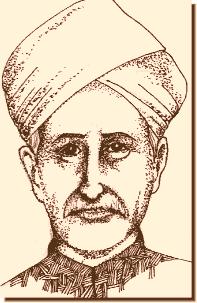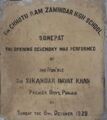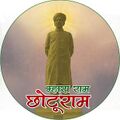Sir Chhotu Ram
Sir Chhotu Ram
Introduction
Sir Chhotu Ram(1881-1945) was one of the most prominent pre-partition politicians in Punjab and an ideologue of the Jat peasantry and a champion of its interests. He was born on 24 November 1881 in Ghari Sampla in Rohtak district in Jat Gotra Ohlan family.
He was associated with organizations representing peasant interests like the Zamindar League and the Unionist Party (after resigning from the Congress in 1920). He was one of the founders of the Unionist Party (along with Sir Sikander Hyat Khan). The Unionists ruled Punjab for its first two decades of (limited) democracy. They represented a coalition between Hindu farmers in the eastern part of the province and feudal Muslim landlords in the west . As an important minister (he held the revenue portfolio) in the then Unionist Party Government in Punjab, he did a lot to improve the economic status of the peasants through numerous legislative measures.
Sir Chhotu Ram led a massive recruitment drive for the army during World War I in modern Haryana region and during World War II across pre-partion Punjab. His support of the British war effort (during world war II) is often seen as a controversial step as the Congress had given a call not to provide any help to the British. He actively promoted recruitment of Jats in particular and other farming class youth in general in the army as he felt that it was economically beneficial to these communities.
The recurring theme of his campaigns was India's independence after the war. He said: "My hope is that after this war Hindustan will be free. And it will be free in a real sense."
Sir Chhotu Ram opposed the concept of Pakistan and formed a separate group of thirteen members in the Punjab Assembly when most Muslim Unionists joined the Muslim League. His death brought about the demise of the Unionist Party.
Growing up in the prevailing economic misery at his time, he was strongly influenced and motivated by the slights and insults, intended and otherwise, that he had undergone on the path to achieve education. In his times, the Jat peasants were victims of exploitation at the hands of the usurious Mahajans. He exhorted peasants to shed their inferiority complex and fatalistic outlook and become assertive and self-confident.
He played a very significant role in the organization of the Jats as a self-conscious community and helped them acquire self-confidence and self-respect. As he was outside the political mainstream (Congress), his contribution has been rather unfairly neglected by the historians by not including it in Indian history books.
The Early Years
{{#ev:youtube|3FORDtMQ6k0|300|right|Documentary on the life of Sir Chhotu Ram}}
Sir Chhotu Ram (Gotra Ohlan) was born on 24 November 1881 in Ghari Sampla in Rohtak district. His great-grandfather, Ram Rattan, owned a dry and unproductive holding of about 10 acres. Debts and litigation compounded the problems of his father, Chaudhary Sukhi Ram, who died in 1905 leaving behind a heavy debt.It is interesting and important to consider his love's depth for Farmer community that on the occasion of Basant-Panchmi, in a Farmer-Gathering, he declared his desire to celeberate his Birth Day on the festival of Basant-Panchmi.Only this wish indicates his fathomless attachment towards Farmers.
Chhotu Ram joined a primary school in Jan 1891, passing out four years later. He studied for his middle school examination in Jhajjar, 12 miles from his village.
He left Jhajjar to be enrolled in the Christan Mission School in Delhi, though it was not easy for the family to raise the funds for his education. The story goes that when the father and son approached the bania at Sampla mandi for a loan, the bania flung a fan at the father 'with unspoken indignation to cool his large perspiring semi-naked body'. This and other humiliating incidents, later recalled by Sir Chhotu Ram himself, left an indelible mark on his personaily and world view. He reminiscenced in 1942, "I was born and brought up in rural sorroundings which gave me a close and deep in site into the handicaps, difficulties, trials and turbulations, of the rural population. This insight could not have failed to influence the whole course of my psycological and moral growth... Side by side with the imperceptible and constant working of this factor, a deep and passionate love for the Jat tribe in which I was born warmed my heart from early life."
Sir Chhotu Ram's stay at the Christan Mission School was eventful He organised a strike against the in-charge of the boarding house for which he was given the nick name 'General Roberts'.
In 1901 he returned to his village and passed his imtermediate examination in 1903. Thereafter, he enrolled in St Stephens College from where he graduated in 1905. It was his stay at this college that he was drawn to the Arya Samaj, though he had already identified himself as adherent of Vedic Dharma in the admission form of the intermediate examination.
He studied Sanskrit rather than English, the preferred subject of most fellow students from wealthy backgrounds. He was particularly concerned with the educational and economical backwardness of the Jats. He felt hurt by the (often good humored) epithets potraying fellows from the countryside, and especially Jats, as rustics, clowns and bumpkins. He recounted, "...The epithets were used in perfectly good humour, with no desire to hurt...but it would be idle to rpetend that they did not proceed from an undercurrent of feeling which, though innocent in appearance, had a vein of disrespect and disdain for my class. Unpleasant heart searching followed, and nurtured the sapling which had been firmly planted in me by the couplet which said, 'in the ordinary course of nature, thousands upon thousands are born everyday, but he alone is truly born whose birth leads to the elevation of the race.' This couplet (hitopedesha) which I had read in one of my textbooks for the first time in 1897 had sown in my young breast the seed of that inchoate desire which in later years grew into a powerful passion for uplifting my class educationally, socially, economically, and politically."
In an article published in the college magazine in 1907, he reflected on the ways to improve the life in rural areas, to end the isolation of people and curb the monopoly of the village bania, whom he called 'the incarnation of Shylock in our times'.
Early Public Life
{{#ev:youtube|zMpyO2Yue0g|300|right|Documentary on the life of Sir Chhotu Ram}}
In 1905, he worked as the Assistant Private Secretary to Raja Rampal Singh of Kalakankar in the United Provinces, but left the job within a month because he resented the Raja's attitude towards him on one particular occasion. He moved to Bharatpur, where he did not find suitable employment. He returned to Kalakankar in 1907 and worked for a few months as the editor of the English newspaper Hindustan and then proceeded to study law in Agra, where he took his degree in 1911.
While teaching at St John's High School and reading law in Agra, Chhotu Ram studied the local conditions in the Agra and Meerut divisions. This knowledge strengthened his desire to 'respond to the inner call for action in the direction of improving the condition of the Jats'.
In 1911 he became the honorary superintendent of the Jat Boarding House Agra. In 1912 he set up his legal practice with Chaudhary Lal Chand. Both became involved in recruiting soldiers during the First World War. Owning to their efforts, the Jats provided about half of the total recruits in the Rohtak region. Recruitment figures rose from 6,245 in Jan 1915 to 22,144 in Nov 1918.
A patron of several Jat bodies, Sir Chhotu Ram established the Jat Sabha at Rohtak in 1912. He founded educational institutions, including the Jat Arya Vedic Sanskrit High School in Rohtak and donated the first year's revenue of his grant of five squares of Colony Land to the school after the First World War. The Jat Arya Samajists from the Rohtak-Hissar region arranged a meeting in Rohtak on 1 April 1913 to discuss the establishment of the Jat School which was then established on 7 Sept 1913.
He encouraged Jat students to join the Young Jat Association and study at the Jat School in Rohtak and at St Stephen's College and provided support to students for the same.
He exhorted his friends to wear the sacred thread to establish their identity. He attached much social significance to the thread. He saw it as 'a sign of Dwija or twice born, a status conceded to a Jat by the orthodox Hindu only grudgingly'.
Sir Chhotu Ram writing in the Jat Gazzatte in 1916, aired other Jat grievances such as a lack of representation in the judicial bench at Sonipat. Between 1916 and 1919, he wrote again the bahis (account book) and the cruel manner in which moneylenders obtained decrees against poor and ignorant zamindars. In general, he dwelt on their backwardness and their exploitation by the brahman-bania combine who acted in collusion with the Raj.
Emergence as a leader
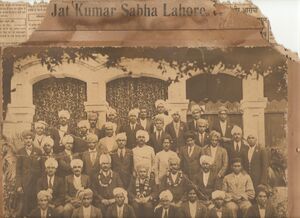
A Leader should have a vision, be soft spoken, and carry a compassionate soul. Sir Chhotu Ram translated all this in action. During the period lasting well over two decades, Chhotu Ram had not only filled some very difficult roles with distinction - as, for instance, the co-founder of the Unionist Party, Leader of the party in the Legislature, Minister for Agriculture and development alternately, President of the Council for a short span of time - but also expanded a philosophy of secularism that is as much commended today as in his own times. While the non-agriculturists had outclassed the agriculturists in producing really outstanding men in almost all fields of human concern, especially in the spread of quality education, there had been a tragic dearth of such dedicated men in the rural areas during the last many decades, if not centuries.
Sir Chhotu Ram worked as the president of the Rohtak District Congress Committee from 1916 to 1920. He resigned on 8 Nov 1920, because the Punjab Provincial Congress Committee identified with the urban and the commercial classes, had ignored the rights and claims of the rural population. He made it clear that if he had to make a choice between an urban Hindu and a Muslim agriculturist, he would unhesitantly sympathize with the latter.
What possibly also prompted him to leave the Congress was his conviction that a disadvantaged class like the Jats could not afford to fight against the government (and the Congress essentially stood for anti-government).
He was emerging as the sole spokesman of Jat interests by this time. In the 1920s and 30s, he not only founded various organizations but was the chief inspiration behind the assertion of a specifically Jat identity in Punjab society and politics.
After the war Sir Chhotu Ram extended his activities beyond Rohtak. He set out to mobilize Jats in (the areas of present-day) Rajasthan and western Uttar Pradesh, where they were already being organized by the Jat Sabha. During the war years, and also thereafter, he developed links with Jat and Arya Samajist leaders, such as Chaudhary Piru Singh, manager of the gurukul in Matindu. Soon he became Piru Singh's legal advisor. His association with the gurukul also brought him in contact with Swami Shraddhanand and he began visiting him in Delhi. His close ally in Rohtak was Master Nathu Ram, who worked as a 'recruiting orator' and was popular as an Arya Samaj preacher.
Sir Chhotu Ram's association with the local Arya Samajists caused some complaints from the official quarters. They dubbed his undertaking for the advancement of the Jat community and the propagation of Arya doctrines as 'bordering on fanaticism'. He tried to assuage their fears by pointing out, "A Jat Arya Samajist has very little in common with the type of Arya Samajist whom the government has been accustomed to distrust."
He did so to ensure that the British did not impose restrictions on recruiting Jats in the army. He was convinced that recruitment to the army was economically beneficial and helped Jats to emphasize their Kshatriya status.
In 1925 he organized a All India Jat Mahasabha Jalsa at Pushkar in Rajasthan, momentous event in Jat history. In 1934 he organized a rally of 10,000 Jat peasants in Sikar in Rajasthan to launch an anti-rent campaign. The campaigners donned the sacred thread, made offerings of ghee and read from the Satyarth Prakash. The rally was a major event and enhanced his stature.
After 1920, Sir Chhotu Ram also tried to create a non-sectarian peasant group consciousness. He was actively associated with the Punjab Zamindar Central Association, established in 1917 to advance the interests of Hindu and Sikh Jat agriculturalists. This was the first step towards the formation of a homogeneous rural block based on economics rather than religious interests. His demands, which were later adopted by the Punjab legislative council, called for separate rural and urban constituencies, the allotment of seats in proportion to the population and limiting representation in rural areas to 'agriculturists'. The formation in 1923 of the Unionist Party, a cross-communal alliance of Hindu Jats and Muslim agriculturists committed to the Land Alienation Act of 1900 was the culmination of this process. This also reflected the emerging tensions between urban and rural Arya Samajists.There were many leaders in the Unionist Party hailing from far-flung rural areas - notably, Mian Fazl-i-Husain, Surjit Singh Majithia, Joginder Singh, Sikandar Hyat Khan, besides a number of nawabzadas - yet none was interested in seeking redressal of the peasants' grievances. It is not Known to many that the Bhakhra Dam Scheme was initially got approved by Sir Chhotu Ram.He laid the foundation of the 'Green Revolution' . A substantial portion of his salary as Minister, was set aside as scholarships to bright poor students. Sir Chhotu Ram collected a large amount of funds for the victims of Bihar earthquake of 1934. These were the Punjab Relief Indebtedness Act,1934 and the Punjab Debtor's Protection Act 1936, which emancipated the peasants from the clutches of the money lenders and restored the right of land to the tiller. However, it was Chottu Ram, more than any other, who spectacularly symbolized the cause of the peasants during the darkest hour of modern Indian history.
He asserted that the impoverishment of the peasantry was itself the sole cause of indebtedness. He challenged official assumptions on the 'wasteful habits' of peasants and the 'overspending' on marriage, death and festivals. He insisted that land revenue was the principal cause of indebtedness and ruin. He rejected the advocacy of cooperatives as a method to curb moneylenders, arguing instead that market forces would not release the peasantry from debt.
Nor did he agree with Mahatma Gandhi and Jawaharlal Nehru who regarded the peasants as a passive identity. He saw the peasant as the agent as well as the beneficiary of the change.
Role in Bhakra Dam
The Bhakra-Nangal multipurpose dams were among the earliest river valley development schemes undertaken by India after independence though the project had been conceived long before India became a free nation. The agreement for this project had been signed by the then Punjab Revenue Minister, Sir Chhotu Ram in November 1944 with Raja of Bilaspur and finalised the project plan on 8 January 1945. Preliminary works commenced in 1946. Construction of the dam started in 1948; Jawaharlal Nehru poured the first bucket of concrete into the dry riverbed of the Sutlej on 17 November 1955, as a symbolic initiation of the work. Addressing a gathering there, he said, "This is a gift to the people of India and to the future generations from the workers who built this dam", calling for "raising a memorial" at the dam "in honour" of the workers.[1] The dam was completed by the end of 1963. Successive stages were completed by the early 1970s.
Initially, the construction of the dam was started by Sir Louis Dane, the Lieutenant Governor of Punjab. But the project got delayed and was restarted soon after independence under the chief architect Rai Bahadur Kunwar Sen Gupta. It was financed entirely by the union government. The Control Board for the project included representatives from union government, and of the governments of Punjab, Patiala and East Punjab States Union, Rajasthan, Bilaspur and Himachal Pradesh. The organisation evolved for the purpose of design and construction was divided into three parts. The Designs Directorate provided the designs and drawings. The Construction and Plant Design Directorate was to look after its execution and installing of the plant, while the Directorate of Inspection and Control ensured that the specifications are accorded to safety requirements were met.[2]
In October 1963, at the ceremony to mark the dedication of the Bhakra–Nangal project to the nation, Prime Minister Nehru said, "This dam has been built with the unrelenting toil of man for the benefit of mankind and therefore is worthy of worship. May you call it a Temple or a Gurdwara or a Mosque, it inspires our admiration and reverence". On 22 October 2013, the Government of India approved the release of a commemorative stamp to mark the 50th anniversary of the Bhakra Dam. As how successful India was at that time that it was the only dam in Asia which could produce 1500 MW power.
Original Videos of Sir Chhotu Ram
1.Sir Chhotu Ram addressing people. {{#ev:youtube|bI56omUxyUM|300|right}}
2.Sir Chhotu Ram at Lahore Tea Party {{#ev:youtube|97XVF83okeU|300|right}}
Documentary over the Life of Sir Chhotu Ram
Here are the You tube video links of the documentary at Sir Chhotu Ram Life :-
1.http://www.youtube.com/watch?v=3FORDtMQ6k0
2.http://www.youtube.com/watch?v=C8UAvOmbSLQ
3.http://www.youtube.com/watch?v=YfZc877DkE0
4.http://www.youtube.com/watch?v=bOcVBTE84Cs
5.http://www.youtube.com/watch?v=zMpyO2Yue0g
6.http://www.youtube.com/watch?v=TPS6ciq7xG0
Writings
Sir Chhotu Ram began writing while in college and continued through out his public life. Among his most influencial writings was 'Thug Bazaar ki Sair'. This was followed by another series, 'Bechara Zamindar', of which 17 appeared in the Jat Gazette. The first series of 'Bechara Zamindar' was written in 1935 and the second in 1936.
'Bechara Zamindar' provides perhaps one of the best insights into Sir Chhotu Ram's political ideology. The series indicated his commitment to the Punjab peasant. He described the peasant as a 'peculiar' being, with 'enormous and difficult responsibilities, but whose rights were always invisible'. He wrote in the Jat Gazatte of 22 March 1935, "In some provinces zamindars are different from peasants. But in Punjab the 2 are synonymous. Here the agriculturists who has proprietary rights in land is the one who actually plows it."
In 'Bechara Zamindar' (and other writings) he saw the peasant as basically naive, uninformed and unaware of the changes taking place around him. In the same pamphlet, he underlines those factors that prevented the peasant from being politically organized and economically developed. One was the narrow religious obscurantism which clouded his vision, heightened 'communal sentiments and destroyed his path'. For this reason, he targeted many superstitiuos beliefs and practices in rural areas and reminded the peasants, "Some exploit you by masqueranding as pirs; some as purohits; some as shah; some through bribery. .... Sometimes you are deceived in account. If you are prosperous then doms, miraris, bhats deceive you. If you are poor, then the moneylender sucks you like a leech. O peasant, how will you survive these demons....!"
In the chapter 'A New Message', he asked peasants to discard puranic or orthodox ideas, adopt 'new ideas' shed their fatalistic outlook aquire a vision and gain self confidence and self-respect. Quoting from the Persian and Urdu poet Mohammad Iqbal, he urged the peasants to be self-reliant. He asked them to 'aquire the traits of a lion' and not to be influenced either by the moneylender or the government or by organizations like Congress, Hindu Mahasabha, Muslim League, Sikh League (among others). Instead they should rally around the Zamindar League and take advantage of its activities. He wrote, "I want to see the Punjab peasant prosperous and united .... awakened and standing on his feet, in action and organization."
Though 'Bechara Zamindar' could not be widely read by the rural population, its message was communicated by, among others, the bhajniks. Its appeal was further enhanced because the allegories and stories, along with the dialect, were rooted in the belief system and culture of the Jats (and peasants in general).
Relations with the British
There was an ambivalent relationship between Sir Chhotu Ram and the British, an aspect ignored by historians who have studied his role within the framework of military loyalism and imperial patronage in Punjab. These historians view the Jats as the mainstay of imperial authority in Punjab and regard Chhotu Ram as the spokesman of the rich and middle peasants. The reality, however, is that he was primarily concerned with the plight of the deprived, the downtrodden and the neglected.
He responded to imperial structures and forged tactical alliances with the British and with other agriculturists to further the combined interests of Hindu, Muslim and Sikh Jats and consolidate the cultural and territorial identity of Haryana Jats.
Sir Chhotu Ram was equally vocal in assailing the pre-colonial state for its unjustifiable claims over land. He critized the British for reinforcing pre-colonial principles of 'darkness' by claiming ownership of land.By putting forth his own conception of peasant identity, he moved away from the prevalent political rethoric of the Unionist Party (between 1925 and 33), which was primarily concerned with the greater employment of zamindars in government service.
The attachment to land, one of the crucial features of Jat identity, concerned him most. He denounced the government's claim that 'the real owner of the land is the king, the emperor or the government', and maintained that the government's view that it had conferred proprietary rights was 'principally and historically wrong'.
He argued that a peasant was called a peasant by virtue of his ownership of the land. He also demanded the recognition of women as cultivators.
By the 30s, he was disenchanted with the colonial state. His pronouncements disturbed officials in Punjab who went so far as to accuse him of spreading socialism among peasants. The Punjab legislative council also came in for criticism for its lack of concern for the peasant. He said, "our brothers (especially in the Punjab council) were no better in so far as they supported the false claims of the government (in this regard)."
While recognizing the role of the colonial state in the life of the peasant, Sir Chhotu Ram exposed the government's discriminatory policy towards agriculturists, and their lack of representation in public services.
Conclusion
Sir Chhotu Ram's ideology combined the endorsment of certain Hindu cultural claims of the Jats with the need for a secular, rural identity for agriculturist communities. While his paradoxial political stance provided the context for the strengthening of the Jat identity, his pro-agriculturist ideology was appropriated by the Unionists and contributed to their electoral success in 1937.
His own understanding of the Jat identity combined the themes of caste (Kshatriya) assertions and land ownership. "The Jats are a quam of warriors and zamindars", he wrote.
His political language drew upon peasant culture and the warrior traditions of the Jats. In this respect, he differed from the other Unionist leaders whose activities were confined to the formal imperial structures and not connected with any mass movement in Punjab.
He worked to project the Jats as a community lacking in self-confidence and in need for both protection and recognition, to boster their self-confidence and transform them into a politically, culturally and economically viable entity.
Equally he broadened the meaning of Jat identity by unifying the cultural strands of the Hindu Jats of Rajasthan, UP and southeast Punjab by providing them with a common language against the cultural subordination of the brahman-bania castes. He did not confine Jatness to a class but rather projected it as a homogeneous cultural community with its distinct identity. Moreover, he was able to establish a direct and close connection with other peasant groupings in Punjab.
The sahukar or bania (moneylender) was a major motif in his narratives. Potrayed as an 'evil force' within the countryside with his easy access to law, land and capital, the moneylender was constantly chided and ridiculed for manipulating prices and controlling marketing and debt relations. He bemoaned the Jat peasants' subservience to the banias.
He employed the bhajniks to propagate the concept of biradari (peasant brotherhood) among the different peasant groups, who in turn saw him as a leader who spoke their language and responded to their needs and aspirations.
After his death in 1945, he was equated with Dayanand Saraswati, their names evoking notions of heroism and serving as reference points for the collective identity of the Jats. Muslim Jats too gave him the title of Rehbar-i-Azam (a great protector).
Practice subordination of the interests of the individual to the interests of the community systematically, until it becomes a habit. - Sir Chhotu Ram
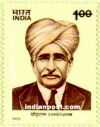
Postal Stamp
Indian Postal Department issued a commemorative stamp on him on 09/01/1995 of Denomination 1.00.[3]
The statue of Sir Chhotu Ram
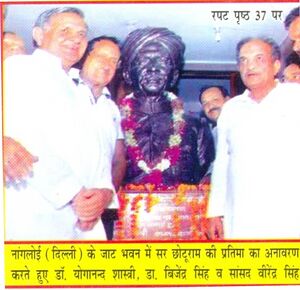
The statue of Sir Chhotu Ram has been installed at Jat Dharmshala in village Nangloi (Delhi) on 10 August 2013. It was inaugurated by Dr. Yoganand Shastri: speaker Delhi Assembly, Ch. Virendra Singh, Dr. Vijendra Singh Nangloi MLA. etc. [4]
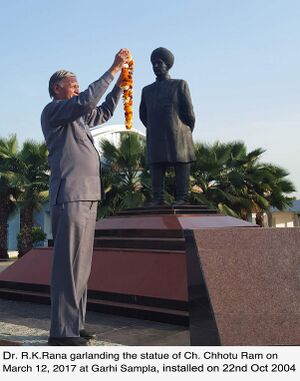
चौधरी छोटूराम पर हिन्दी में एक लेख
रहबर-ए-आजम, गरीबों और किसानों के मसीहा, भारत माता के महान् सेवक सर छोटूराम का जन्म 24 नवम्बर 1881 में झज्जर के छोटे से गांव गढ़ी सांपला में बहुत ही साधारण परिवार में हुआ (झज्जर उस समय रोहतक जिले का ही अंग था)। छोटूराम का असली नाम राय रिछपाल था । अपने भाइयों में से सबसे छोटे थे इसलिए सारे परिवार के लोग इन्हें छोटू कहकर पुकारते थे । स्कूल रजिस्टर में भी इनका नाम छोटूराम ही लिखा दिया गया और ये महापुरुष छोटूराम के नाम से ही विख्यात हुए । उनके दादाश्री रामरत्न के पास 10 एकड़ बंजर व बारानी जमीन थी । छोटूराम जी के पिता श्री सुखीराम कर्जे और मुकदमों में बुरी तरह से फंसे हुए थे ।
जनवरी सन् 1891 में छोटूराम ने अपने गांव से 12 मील की दूरी पर स्थित मिडिल स्कूल झज्जर में प्राइमरी शिक्षा ग्रहण की । उसके बाद झज्जर छोड़कर उन्होंने क्रिश्चियन मिशन स्कूल दिल्ली में प्रवेश लिया । लेकिन फीस और शिक्षा का खर्चा वहन करना बहुत बड़ी चुनौती थी उनके समक्ष । छोटूराम जी के अपने ही शब्दों में कि सांपला के साहूकार से जब पिता-पुत्र कर्जा लेने गए तो अपमान की चोट जो साहूकार ने मारी वो छोटूराम को एक महामानव बनाने के दिशा में एक शंखनाद था । छोटूराम के अंदर का क्रान्तिकारी युवा जाग चुका था । अब तो छोटूराम हर अन्याय के विरोध में खड़े होने का नाम हो गया था ।
क्रिश्चियन मिशन स्कूल के छात्रावास के प्रभारी के विरुद्ध श्री छोटूराम के जीवन की पहली विरोधात्मक हड़ताल थी । इस हड़ताल के संचालन को देखकर छोटूराम जी को स्कूल में 'जनरल रोबर्ट' के नाम से पुकारा जाने लगा । सन् 1903 में इंटरमीडियेट परीक्षा पास करने के बाद छोटूराम जी ने दिल्ली के अत्यन्त प्रतिष्ठित सैंट स्टीफन कालेज से 1905 में ग्रेजुएशन की डिग्री प्राप्त की । छोटूराम जी ने अपने जीवन के आरंभिक समय में ही सर्वोत्तम आदर्शों और युवा चरित्रवान छात्र के रूप में वैदिक धर्म और आर्यसमाज में अपनी आस्था बना ली थी ।
सन् 1905 में छोटूराम जी ने कालाकांकर के राजा रामपाल सिंह के सह-निजी सचिव के रूप में कार्य किया और यहीं सन् 1907 तक अंग्रेजी के हिन्दुस्तान समाचारपत्र का संपादन किया । यहां से छोटूराम जी आगरा में वकालत की डिग्री करने आ गए ।
झज्जर जिले में जन्मा यह जुझारू युवा छात्र सन् 1911 में आगरा के जाट छात्रावास का अधीक्षक बना । 1911 में इन्होंने लॉ की डिग्री प्राप्त की । यहां रहकर छोटूराम जी ने मेरठ और आगरा डिवीजन की सामाजिक दशा का गहन अध्ययन किया । 1912 में आपने चौधरी लालचंद के साथ वकालत आरंभ कर दी और उसी साल जाट सभा का गठन किया । प्रथम विश्वयुद्ध के समय में चौधरी छोटूराम जी ने रोहतक से 22,144 जाट सैनिक भरती करवाये जो सारे अन्य सैनिकों का आधा भाग था । अब तो चौ. छोटूराम एक महान क्रांतिकारी समाज सुधारक के रूप में अपना स्थान बना चुके थे । इन्होंने अनेक शिक्षण संस्थानों की स्थापना की जिसमें "जाट आर्य-वैदिक संस्कृत हाई स्कूल रोहतक" प्रमुख है । एक जनवरी 1913 को जाट आर्य-समाज ने रोहतक में एक विशाल सभा की जिसमें जाट स्कूल की स्थापना का प्रस्ताव पारित किया जिसके फलस्वरूप 7 सितम्बर 1913 में जाट स्कूल की स्थापना हुई ।
वकालत जैसे व्यवसाय में भी चौधरी साहब ने नए ऐतिहासिक आयाम जोड़े । उन्होंने झूठे मुकदमे न लेना, छल-कपट से दूर रहना, गरीबों को निःशुल्क कानूनी सलाह देना, मुव्वकिलों के साथ सद्व्यवहार करना, अपने वकालती जीवन का आदर्श बनाया ।
इन्हीं सिद्धान्तों का पालन करके केवल पेशे में ही नहीं, बल्कि जीवन के हर पहलू में चौधरी साहब बहुत ऊंचे उठ गये थे । इन्हीं दिनों 1915 में चौधरी छोटूराम जी ने 'जाट गजट' नाम का क्रांतिकारी अखबार शुरू किया जो हरयाणा का सबसे पुराना अखबार है, जो आज भी छपता है और जिसके माध्यम से छोटूराम जी ने ग्रामीण जनजीवन का उत्थान और साहूकारों द्वारा गरीब किसानों के शोषण पर एक सारगर्भित दर्शन दिया था जिस पर शोध की जा सकती है । चौधरी साहब ने किसानों को सही जीवन जीने का मूलमंत्र दिया । जाटों का सोनीपत की जुडिशियल बैंच में कोई प्रतिनिधि न होना, बहियों का विरोध, जिनके जरिये गरीब किसानों की जमीनों को गिरवी रखा जाता था, राज के साथ जुड़ी हुई साहूकार कोमों का विरोध जो किसानों की दुर्दशा के जिम्मेवार थे, के संदर्भ में किसान के शोषण के विरुद्ध उन्होंने डटकर प्रचार किया । उनके स्वयं के शब्दों में –
"किसान कुंभकरण की नींद सो रहा है, मैं जगाने की कौशिश कर रहा हूं - कभी तलवे में गुदगुदी करता हूं, कभी मुंह पर ठंडे पानी के छींटे मारता हूं । वह आंखें खोलता है, करवट लेता है, अंगड़ाई लेता है और फिर जम्हाई लेकर सो जाता है । बात यह है कि किसान से फायदा उठाने वाली जमात एक ऐसी गैस अपने पास रखती है जिससे तुरंत बेहोशी पैदा हो जाती है और किसान फिर सो जाता है ।"
चौधरी साहब आगे लिखते हैं –
"किसान को लोग अन्नदाता तो कहते हैं लेकिन यह कोई नहीं देखता कि वह अन्न खाता भी है या नहीं । जो कमाता है वह भूखा रहे यह दुनिया का सबसे बड़ा आश्चर्य है । मैं राजा-नवाबों और हिन्दुस्तान की सभी प्रकार की सरकारों को कहता हूं कि वो किसान को इस कद्र तंग न करें कि वह उठ खड़ा हो । इस भोलानाथ को इतना तंग न करो कि वह तांडव नृत्य कर बैठे । दूसरे लोग जब सरकार से नाराज होते हैं तो कानून तोड़ते हैं, किसान जब नाराज होगा तो कानून ही नहीं तोड़ेगा, सरकार की पीठ भी तोड़ेगा ।"
चौ. छोटूराम ने राष्ट्र के स्वाधीनता संग्राम में डटकर भाग लिया । 1916 में पहली बार रोहतक में कांग्रेस कमेटी का गठन किया गया और चौ. छोटूराम रोहतक कांग्रेस कमेटी के प्रथम प्रधान बने । सारे जिले में चौधरी छोटूराम का आह्वान अंग्रेजी हुकूमत को कंपकपा देता था । चौधरी साहब के लेखों और कार्य को अंग्रेजों ने बहुत 'भयानक' करार दिया । फलःस्वरूप रोहतक के डिप्टी कमिश्नर ने तत्कालीन अंग्रेजी सरकार से चौधरी छोटूराम को देश-निकाले की सिफारिश कर दी । पंजाब सरकार ने अंग्रेज हुकमरानों को बताया कि चौधरी छोटूराम अपने आप में एक क्रांति हैं, उनका देश निकाला गदर मचा देगा, खून की नदियां बह जायेंगी । किसानों का एक-एक बच्चा चौधरी छोटूराम हो जायेगा । अंग्रेजों के हाथ कांप गए और कमिश्नर की सिफारिश को रद्द कर दिया गया ।
चौधरी छोटूराम, लाला श्याम लाल और उनके तीन वकील साथियों, नवल सिंह, लाला लालचंद जैन और खान मुश्ताक हुसैन ने रोहतक में एक ऐतिहासिक जलसे में मार्शल के दिनों में साम्राज्यशाही द्वारा किए गए अत्याचारों की घोर निंदा की । सारे इलाके में एक भूचाल सा आ गया । अंग्रेजी हुकमरानों की नींद उड़ गई । चौधरी छोटूराम व इनके साथियों को नौकरशाही ने अपने रोष का निशाना बना दिया और कारण बताओ नोटिस जारी किए गए कि क्यों न इनके वकालत के लाइसेंस रद्द कर दिये जायें । मुकदमा बहुत दिनों तक सैशन की अदालत में चलता रहा और आखिर चौधरी छोटूराम की जीत हुई । यह जीत नागरिक अधिकारों की जीत थी ।
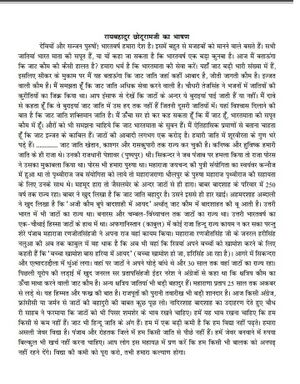
अगस्त 1920 में चौ. छोटूराम ने कांग्रेस छोड़ दी क्योंकि चौधरी साहब गांधी जी के असहयोग आंदोलन से सहमत नहीं थे । उनका विचार था कि इस आंदोलन से किसानों का हित नहीं होगा । उनका मत था कि आजादी की लड़ाई संवैधानिक तरीके से लड़ी जाए । कुछ बातों पर वैचारिक मतभेद होते हुए भी चौधरी साहब महात्मा गांधी की महानता के प्रशंसक रहे और कांग्रेस को अच्छी जमात कहते थे । चौ. छोटूराम ने अपना कार्य क्षेत्र उत्तर प्रदेश, राजस्थान और पंजाब तक फैला लिया और जाटों का सशक्त संगठन तैयार किया । आर्यसमाज और जाटों को एक मंच पर लाने के लिए उन्होंने स्वामी श्रद्धानन्द और भटिंडा गुरुकुल के मैनेजर चौधरी पीरूराम से संपर्क साध लिया और उसके कानूनी सलाहकार बन गए ।
सन् 1925 में राजस्थान में पुष्कर के पवित्र स्थान पर चौधरी छोटूराम ने एक ऐतिहासिक जलसे का आयोजन किया । सन् 1934 में राजस्थान के सीकर शहर में किराया कानून के विरोध में एक अभूतपूर्व रैली का आयोजन किया गया, जिसमें 10,000 जाट किसान शामिल हुए । यहां पर जनेऊ और देसी घी दान किया गया, महर्षि दयानन्द के सत्यार्थ प्रकाश के श्लोकों का उच्चारण किया गया । इस रैली से चौधरी छोटूराम भारतवर्ष की राजनीति के स्तम्भ बन गए ।
पंजाब में रौलट एक्ट के विरुद्ध आन्दोलन को दबाने के लिए मार्शल लॉ लागू कर दिया गया था जिसके परिणामस्वरूप देश की राजनीति में एक अजीबोगरीब मोड़ आ गया ।
एक तरफ गांधी जी का असहयोग आंदोलन था तो दूसरी ओर प्रांतीय स्तर पर चौधरी छोटूराम और चौ. लालचंद आदि जाट नेताओं ने अंग्रेजी हुकूमत के साथ सहयोग की नीति अपना ली थी । पंजाब में मांटेग्यू चैम्सफोर्ड सुधार लागू हो गए थे, सर फ़जले हुसैन ने खेतिहर किसानों की एक पार्टी जमींदारा पार्टी खड़ी कर दी । चौ. छोटूराम व इसके साथियों ने सर फ़जले हुसैन के साथ गठबंधन कर लिया और सर सिकंदर हयात खान के साथ मिलकर यूनियनिस्ट पार्टी का गठन किया । तब से हरयाणा में दो परस्पर विरोधी आंदोलन चलते रहे । चौधरी छोटूराम का टकराव एक ओर कांग्रेस से था तथा दूसरी ओर शहरी हिन्दु नेताओं व साहूकारों से होता था ।
चौधरी छोटूराम की जमींदारा पार्टी किसान, मजदूर, मुसलमान, सिख और शोषित लोगों की पार्टी थी । लेकिन यह पार्टी अंग्रेजों से टक्कर लेने को तैयार नहीं थी । हिंदू सभा व दूसरे शहरी हिन्दुओं की पार्टियों से चौधरी छोटूराम का मतभेद था । भारत सरकार अधिनियम 1919 के तहत 1920 में आम चुनाव कराए गए । इसका कांग्रेस ने बहिष्कार किया और चौ. छोटूराम व लालसिंह जमींदरा पार्टी से विजयी हुए । उधर 1930 में कांग्रेस ने एक और जाट नेता चौधरी देवीलाल को चौ. छोटूराम की पार्टी के विरोध में स्थापित किया । भारत सरकार अधिनियम 1935 के तहत सीमित लोकतंत्र के चुनाव 1937 में हुए । इसमें 175 सीटों में से यूनियनिस्ट पार्टी को 99, कांग्रेस को केवल 18, खालसा नेशनलिस्ट को 13 और हिन्दु महासभा को केवल 12 सीटें मिली थीं । हरयाणा देहाती सीट से केवल एक प्रत्याशी चौधरी दुनीचंद ही कांग्रेस से जीत पाये थे ।
चौधरी छोटूराम के कद का अंदाजा इस चुनाव से अंग्रेजों, कांग्रेसियों और सभी विरोधियों को हो गया था । चौधरी छोटूराम की लेखनी जब लिखती थी तो आग उगलती थी । 'ठग बाजार की सैर' और 'बेचारा किसान' के लेखों में से 17 लेख जाट गजट में छपे । 1937 में सिकन्दर हयात खान पंजाब के पहले प्रधानमंत्री बने और झज्जर के ये जुझारू नेता चौ. छोटूराम विकास व राजस्व मंत्री बने और गरीब किसान के मसीहा बन गए । चौधरी छोटूराम ने अनेक समाज सुधारक कानूनों के जरिए किसानों को शोषण से निज़ात दिलवाई ।
साहूकार पंजीकरण एक्ट - 1938 यह कानून 2 सितंबर 1938 को प्रभावी हुआ था । इसके अनुसार कोई भी साहूकार बिना पंजीकरण के किसी को कर्ज़ नहीं दे पाएगा और न ही किसानों पर अदालत में मुकदमा कर पायेगा । इस अधिनियम के कारण साहूकारों की एक फौज पर अंकुश लग गया ।
गिरवी जमीनों की मुफ्त वापसी एक्ट - 1938
यह कानून 9 सितंबर 1938 को प्रभावी हुआ । इस अधिनियम के जरिए जो जमीनें 8 जून 1901 के बाद कुर्की से बेची हुई थी तथा 37 सालों से गिरवी चली आ रही थीं, वो सारी जमीनें किसानों को वापिस दिलवाई गईं । इस कानून के तहत केवल एक सादे कागज पर जिलाधीश को प्रार्थना-पत्र देना होता था । इस कानून में अगर मूलराशि का दोगुणा धन साहूकार प्राप्त कर चुका है तो किसान को जमीन का पूर्ण स्वामित्व दिये जाने का प्रावधान किया गया ।
कृषि उत्पाद मंडी अधिनियम - 1938
यह अधिनियम 5 मई, 1939 से प्रभावी माना गया । इसके तहत नोटिफाइड एरिया में मार्किट कमेटियों का गठन किया गया । एक कमीशन की रिपोर्ट के अनुसार किसानों को अपनी फसल का मूल्य एक रुपये में से 60 पैसे ही मिल पाता था । अनेक कटौतियों का सामना किसानों को करना पड़ता था । आढ़त, तुलाई, रोलाई, मुनीमी, पल्लेदारी और कितनी ही कटौतियां होती थीं । इस अधिनियम के तहत किसानों को उसकी फसल का उचित मूल्य दिलवाने का नियम बना । आढ़तियों के शोषण से किसानों को निजात इसी अधिनियम ने दिलवाई ।
व्यवसाय श्रमिक अधिनियम - 1940
यह अधिनियम 11 जून 1940 को लागू हुआ । बंधुआ मजदूरी पर रोक लगाए जाने वाले इस कानून ने मजदूरों को शोषण से निजात दिलाई । सप्ताह में एक दिन की छुट्टी वेतन सहित और दिन में 8 घंटे काम करने के नियत किये गए । 14 साल से कम उम्र के बच्चों से मजदूरी नहीं कराई जाएगी । दुकान व व्यवसायिक संस्थान रविवार को बंद रहेंगे । छोटी-छोटी गलतियों पर वेतन नहीं काटा जाएगा । जुर्माने की राशि श्रमिक कल्याण के लिए ही प्रयोग हो पाएगी । इन सबकी जांच एक श्रम निरीक्षक द्वारा समय-समय पर की जाया करेगी ।
कर्जा माफी अधिनियम - 1934
यह क्रान्तिकारी ऐतिहासिक अधिनियम दीनबंधु चौधरी छोटूराम ने 8 अप्रैल 1935 में किसान व मजदूर को सूदखोरों के चंगुल से मुक्त कराने के लिए बनवाया । इस कानून के तहत अगर कर्जे का दुगुना पैसा दिया जा चुका है तो ऋणी ऋण-मुक्त समझा जाएगा । इस अधिनियम के तहत कर्जा माफी (रीकैन्सिलेशन) बोर्ड बनाए गए जिसमें एक चेयरमैन और दो सदस्य होते थे । दाम दुप्पटा का नियम लागू किया गया । इसके अनुसार दुधारू पशु, बछड़ा, ऊंट, रेहड़ा, घेर, गितवाड़ आदि आजीविका के साधनों की नीलामी नहीं की जाएगी ।
इस कानून के तहत अपीलकर्ता के संदर्भ में एक दंतकथा बहुत प्रचलित हुई थी कि लाहौर हाईकोर्ट में मुख्य न्यायाधीश सर शादीलाल से एक अपीलकर्ता ने कहा कि मैं बहुत गरीब आदमी हूं, मेरा घर और बैल कुर्की से माफ किया जाए । तब न्यायाधीश सर शादीलाल ने व्यंग्यात्मक लहजे में कहा कि एक छोटूराम नाम का आदमी है, वही ऐसे कानून बनाता है, उसके पास जाओ और कानून बनवा कर लाओ । अपीलकर्ता चौ. छोटूराम के पास आया और यह टिप्पणी सुनाई । चौ. छोटूराम ने कानून में ऐसा संशोधन करवाया कि उस अदालत की सुनवाई पर ही प्रतिबंध लगा दिया और इस तरह चौधरी साहब ने इस व्यंग्य का इस तरह जबरदस्त उत्तर दिया ।
1942 में सर सिकन्दर खान का देहांत हो गया और खिज्र हयात खान तीवाना ने पंजाब की राजसत्ता संभाली । उधर मुहम्मद अली जिन्ना ने 1944 में लाहौर में सर खिज्र हयात पर दबाव डाला कि चौधरी छोटूराम का दबदबा कम किया जाए और पंजाब की यूनियनिस्ट सरकार का लेबल हटाकर इसे मुस्लिम लीग सरकार का नाम दिया जाए । क्योंकि सर छोटूराम अब्दुल कलाम आजाद की नीतियों के समर्थक थे, मुहम्मद अली जिन्ना और चौधरी छोटूराम सीधे टकराव की स्थिति में आ गए । अब तो चौधरी छोटूराम की पार्टी के सामने मुस्लिम लीग और कांग्रेस दोनों ही चुनौती बन गई थीं । लेकिन पहले और दूसरे महायुद्ध में चौधरी छोटूराम द्वारा कांग्रेस के विरोध के बावजूद सैनिकों की भर्ती से अंग्रेज बड़े खुश थे । अंग्रेजों ने हरयाणा के इलाके की वफादारियों से खुश होकर हरयाणा निवासियों को वचन दिया कि भाखड़ा पर बांध बनाकर सतलुज का पानी हरयाणा को दिया जाएगा ।
भाखड़ा बांध में योगदान
सर छोटूराम ने भाखड़ा बांध का प्रस्ताव रखा था । सतलुज के पानी का अधिकार बिलासपुर के राजा का था। झज्जर के महान सपूत सर छोटूराम ने संयुक्त पंजाब के राजस्व मंत्री के रूप में बिलासपुर (हिमाचल) के राजा के साथ 1944 में एक समझौते पर हस्ताक्षर किए और योजना को 8 जनवरी 1945 को अंतिम रूप दिया। इस परियोजना का का प्रारम्भिक काम 1946 में शुरू हो गया।
सन् 1924 से 1945 तक पंजाब की राजनीति के अकेले सूर्य चौ. छोटूराम का 9 जनवरी 1945 को देहावसान हो गया और एक क्रांतिकारी युग का यह सूर्य डूब गया ।
उद्धरण - "झज्जर : इतिहास के आईने से" पेज 192-199
लेखक - आजाद सिंह चाहर
प्रकाशक - हरयाणा साहित्य अकादमी, पंचकूला, 2005
Dndeswal 09:09, 16 December 2007 (EST)
चौ. छोटूराम जयंती - 24 नवम्बर, 2023 (रोहतक)
भाखड़ा नांगल बांध का नाम किसान मसीहा सर छोटूराम हो
महापुरुष स्मृति परिषद रोहतक, 24/11/2023
युग पुरुष चौधरी छोटू राम की जयंती पर जाट भवन में राष्ट्रीय बौद्धिक अधिवेशन का सफल आयोजन हुआ जिसमें केंद्र व राज्य सरकारों से सर्वसम्मति से तीन मुख्य मांगे की जिसमें भाखड़ा नांगल बांध का नाम किसान मसीहा चौधरी छोटूराम के नाम से करने, विद्यालयी पाठ्यक्रमों में से हटाई गई छोटूराम की जीवनी पुन: पढ़ाई जाये, राष्ट्रीय राजमार्ग का नाम चौ छोटूराम राजमार्ग रखा जाए, साथ ही समाजहित के मद्देनजर दहेज व आडंबर रहित विवाह शादियों को दिन के समय आयोजित किया जाए व स्कूल कालेजों में महापुरुषों का और ज्यादा प्रचार किया जाए। हर सामाजिक संस्थान में महापुरुषों की शिक्षाओं के चित्र, कैलेंडर, प्रतिमाएं स्थापित की जाएं जिससे आगामी पीढ़ी को पूरी जानकारी हो सके।
महापुरुष स्मृति परिषद के अध्यक्ष जसबीर मलिक ने बताया कि राष्ट्रस्तरीय आयोजन में दिल्ली, यू.पी., व अन्य राज्यों से इतिहासकार, खाप पंचायतें, सामाजिक संस्थाऐं, सभाएं, बुद्धिजीवी व शहर के वरिष्ठ नागरिकों ने हिस्सा लिया। अधिवेशन के मुख्यातिथि सांसद ब्रिजेंद्र सिंह ने कहा कि आज महापुरुषों के प्रचार हेतु खाप पंचायतों व सामाजिक संस्थाओं को आगे आना होगा। हम सबके राम चौधरी छोटूराम के नारे की विचारधारा को आमजन से जोड़ने की सख्त जरूरत है। मुख्यवक्ता दिल्ली विधानसभा के पूर्व अध्यक्ष डा योगानंद शास्त्री ने सामाजिक उत्थान में छोटूराम को प्रेरक बताया और कहा कि उन्होंने किसान की सोच और दशा बदलने का प्रभावी कार्य किया था। आज की सरकारों को उनके तौर-तरीके अपना कर किसान को महत्व देने की आवश्यकता है। परिषद के महासचिव राजबीर राज्याण ने महापुरुष स्मृति परिषद के द्वारा किए गए कार्यों के बारे में बताया।
कार्यक्रम का शुभारंभ वैदिक सभा के प्रधान डा स्वतंत्रतानंद शास्त्री के द्वारा यज्ञ व प्रवचन से हुआ। एक बार फिर दुबारा पैदा छोटूराम कर दे वाली, भावुक करने वाली रागनी से लोकगायक राधेश्याम सैनी ने सबका मन मोहा। मंच संचालन कर रहे कैप्टन जगवीर मलिक ने महापुरुष दीनबंधु सर चौधरी छोटूराम पर उनकी यादें ताजा की। इस अवसर पर इतिहासकार डा धर्मचंद विद्यालंकार द्वारा आजाद हिंद सरकार के संस्थापक अमर क्रांतिकारी महेंद्र प्रताप सिंह पर महाकाव्य पुस्तक का भी विमोचन किया गया। उदयीमान कवयित्री खुशबू जैन ने चौधरी छोटूराम पर कविता सुना कर सभी में उत्साह का संचार किया। अधिवेशन में ब्रिगेडियर करतार सिंह यादव, जाखड़ खाप से हेडमास्टर ताराचंद जाखड़, रोहतक खाप 84 के प्रधान हरदीप सिंह अहलावत, नरवाल खाप के भलेराम नरवाल, शमशेर सिंह श्योराण, जाट शिक्षण संस्थाओं के पूर्व प्रधान राजसिंह नांदल, सर्वखाप पंचायतों के संयोजक महेंद्र सिंह नांदल, कमांडेंट हवासिंह सांगवान, झुंझनू राजस्थान के इतिहासकार डा. पितराम गोदारा, महापुरुष स्मृति परिषद के अध्यक्ष जसबीर सिंह मलिक, महासचिव राजवीर राज्याण, मास्टर देवराज नांदल, मा. आनद स्वरूप, कैप्टन जगबीर मलिक, कौमी एकता पार्टी के प्रधान व कार्यक्रम सहयोगी मुकेश हुड्डा घुसकानी, प्रेमसिंह दहिया, पूर्णभगत आहूजा, मिथलेश दहिया, डा स्वतंत्रानंद शास्त्री, हुड्डा खाप से धर्मपाल हुड्डा, जगदीश हुड्डा, सचित नांदल, जितेंद्र छात्रर, महावीर सिंह दांगी, इतिहासकार डा धर्मचंद विद्यालंकार, इतिहासकार व पुनिया खाप कार्यकारिणी के वरिष्ठ सदस्य महिपाल आर्य, नवीन जयहिंद, महापुरुष विचार मंच के प्रधान भूपेंद्र सिंह अहलावत रोहिणी, शमशेर सिंह नेहरा, दीपक कपूर, डा. वेदप्रकाश स्योराण, सीनियर सिटीजन क्लब के प्रधान सूरजमल मलिक, वरिष्ठ पत्रकार व समाजसेवी सुरेंद्र खन्ना, श्रीमती विनोद हुड्डा, राजवीर मलिक, हापुड़ से लेखक कर्मवीर प्रधान, पत्रकार नीलम आर्य आदि उपस्थित रहे।
महापुरुष स्मृति परिषद द्वारा आयोजित चौधरी छोटूराम जयंती समारोह के उपलक्ष्य पर पोजीट्रोन हॉस्पिटल की हड्डी व ह्रदय रोग विशेषज्ञ चिकित्सकों द्वारा निशुल्क स्वास्थ्य जांच शिविर का आयोजन भी किया गया जिसमें लोगों का तांता लगा रहा।
- प्रेषक
- आपका प्रिय जसबीर सिंह मलिक
- मुख्य संपादक, प्रकाशक एवं मुद्रक
- जाट रत्न पत्रिका, रोहतक (हरयाणा)
- 9355675622
8 जनवरी 1945 को भाखड़ा-नांगल बांध की फाइल पर हस्ताक्षर
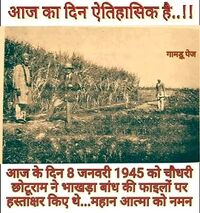
भाखड़ा - नांगल डैम के जनक तत्कालीन पंजाब सरकार में राजस्व मंत्री चौधरी सर छोटू राम थे। उन्होंने ही सबसे पहले इसकी बातचीत बिलासपुर के राजा से मिलकर इसका प्रारूप सन् 1944 में तैयार किया था। 8 जनवरी सन् 1945 ई को सर छोटू राम ने अपने कर कमलों से इसकी आधारशिला रख दी थी। सन् 1946 में इस परियोजना पर निर्माण कार्य की शुरुआत हो गई थी। इसके पीछे गोविंद सागर झील है जो सिखों के दसवें गुरु गुरुगोबिंद सिंह के नाम पर है। आजादी मिलने के समय यह परियोजना कुछ वर्षों के लिए रोक दी गई थी और इसी दौर में चौधरी सर छोटू राम की मृत्यु हो चुकी थी। सन् 1948 में फिर से परियोजना के निर्माण कार्य को शुरू किया गया था । अमेरिकी कंपनी के इंजीनियर हार्वे सलोकेम ने इसका ठेका लेकर इसका निर्माण किया। 22 अक्टूबर सन् 1963 को तत्कालीन प्रधानमंत्री पंडित जवाहरलाल नेहरू ने इसे देश की जनता को समर्पित किया। निश्चित रूप से भारत देश की यह सबसे बड़ी सिंचाई परियोजना है । भाखड़ा नांगल बांध की ऊंचाई 740 फीट है। पंजाब हरियाणा राजस्थान की यह संयुक्त परियोजना 1095 किलोमीटर लंबी है और इसकी शाखाओं की लंबाई 565 किलोमीटर है। यह परियोजना इंदिरा गांधी कैनाल के रूप में राजस्थान के जैसलमेर के अंतिम छोर तक जल उपलब्ध कराती है। ज्ञानसिंह
- संदर्भ - चौ. ज्ञानसिंह दलाल फोन नं. +91-9812700537 (WhatsApp की एक ग्रुप-पोस्ट से संगृहीत)
चौधरी छोटूराम पर पुस्तकें
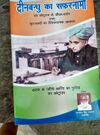
- Deen Bandhu Ka Safarnama: दीनबंधु का सफरनामा - लेखक एडवोकेट नारायणसिंह तेहलान जाट
दीनबंधु सर छोटूराम जी की पुण्यतिथि पर विशेष...
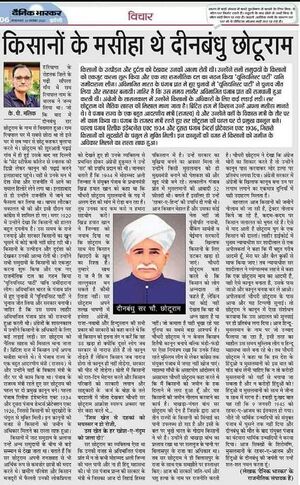
लेखक - के पी मलिक
किसानों के मसीहा कहे जाने वाले सर छोटूराम जी की आज (9 जनवरी) को पुण्यतिथि है। अंग्रेज़ी हुकूमत के दौरान देश के किसानों की तमाम समस्याओं और परेशानियों के निराकरण के लिए अंग्रेजों से भिड़ जाने वाले छोटूराम किसानों के बीच किसी देवता की तरह पूजे जाते थे।
किसानों और कामगारों में पैठ होने के चलते उन्होंने उस समय अंग्रेजों को घुटनों पर आने के लिए मजबूर कर दिया था। साल 1937 के पंजाब के प्रांतीय चुनाव में सर छोटू राम जी की पार्टी ने 175 में से 99 सीट पर जीत हासिल करके सबको आश्चर्य चकित कर दिया था। दरअसल उनकी हिंदू और मुस्लिम दोनों समुदायों में ही गहरी पैंठ थी। इसी का नतीज़ा था कि उनसे अंग्रेज़ हुकूमत खौफ खाती थी।
आज़ भी भारतीय राजनीति में किसानों के हितों को लेकर किए गए उनके कामों की प्रासंगिकता लगातार बनी हुई है। उस समय सर छोटूराम ने ऐसे कई समाज-सुधारक कानून पारित करवाए, जिससे किसानों को शोषण से मुक्ति मिली। इनमें शामिल हैं, पंजाब रिलीफ इंडेब्टनेस (1934), द पंजाब डेब्टर्स प्रोटेक्शन एक्ट (1936), साहूकार पंजीकरण एक्ट-1938, गिरवी जमीनों की मुफ्त वापसी एक्ट-1938, कृषि उत्पाद मंडी अधिनियम-1938, व्यवसाय श्रमिक अधिनियम-1940 और कर्जा माफी अधिनियम-1934 कानून। इन कानूनों में कर्ज का निपटारा किए जाने, उसके ब्याज और किसानों के मूलभूत अधिकारों से जुड़े हुए प्रावधान थे।
कम लोग जानते हैं कि वे एक अच्छे लेखक और पत्रकार भी थे। उन्होंने साल 1915 ने 'जाट गजट' नाम का क्रांतिकारी अखबार शुरू किया था जो हरयाणा का सबसे पुराना अखबार है, जो आज भी छपता है। इस समाचार पत्र के माध्यम से छोटूराम ने ग्रामीण जनजीवन का उत्थान और साहूकारों द्वारा गरीब किसानों के शोषण पर एक सारगर्भित दर्शन दिया था। जिस पर शोध की जा सकती है। उन्होंने किसानों के हितों के लिए लिखे ‘ठग बाज़ार की सैर’ और ‘बेचारा किसान’ सरीखे करीब डेढ़ दर्जन लेख इस "जाट गजट" में लिखे, जिनकी वजह से किसानो के उत्थान के दरवाजें खुले। उन्होंने कहा था..
“मैं राजा-नवाबों और हिन्दुस्तान की सभी प्रकार की सरकारों को कहता हूँ, कि वो किसान को इस कद्र तंग न करें कि वह उठ खड़ा हो…. दूसरे लोग जब सरकार से नाराज़ होते हैं तो कानून तोड़ते हैं, पर किसान जब नाराज़ होगा, तो कानून ही नहीं तोड़ेगा, सरकार की पीठ भी तोड़ेगा।”
आज़ के परिपेक्ष में भी उनकी कही हुई यह बात कई बार सच साबित हो चुकी है। केंद्र की मोदी सरकार की ओर से लाए गए तीन कृषि कानूनों के खिलाफ किसान आंदोलन के दौरान भी सर छोटू राम का नाम खूब गूंजा था। वें हमेशा कहते थे कि 'किसान को लोग अन्नदाता तो कहते हैं, लेकिन यह कोई नहीं देखता कि वह अन्न खाता भी है या नहीं। जो कमाता है वही भूखा रहे, यह दुनिया का सबसे बड़ा आश्चर्य है।'
मुसलमानों के रहबर-ए-आज़म और हिन्दुओं के दीनबंधु और इस महान धरती-पुत्र दीनबंधु सर छोटूराम जी को मेरे जैसे अदने पत्रकार का उनकी पुण्यतिथि पर कोटि-कोटि नमन!
इल्ज़ाम चाहे जो लगा लो, हम सच कहने के आदी हैं! सच कहना अगर बग़ावत है, तो समझो हम भी बाग़ी हैं!!
दीनबंधु चौधरी सर छोटूराम की 137 वीं जयंती
आज (24 November 2018) दीनबंधु चौधरी सर छोटूराम की 137 वीं जयंती है। इन्होंने अपनी लगन और अथक प्रयासों से गरीब मजदूरों और किसानों के कल्याण हेतु अनेकों कदम उठाए। उन्हीं का परिणाम था कि तत्कालीन पंजाब (1947 से पहले का अविभाजित पंजाब )के किसानों और मजदूरों को साहूकारो के चंगुल से मुक्ति मिली। इसीलिए सारे पंजाब में एक गीत गाया जाने लगा जिसके बोल कुछ इस प्रकार थे :---
- मुसलमान कहवैं छोटा खुदा,
- हिंदू छोटूराम तनैं।
- दुनिया के म्हां रौशन कर दिया,
- गढ़ी सांपला गाम तनै।।
उस समय गरीब किसान सूदखोर महाजनों के चंगुल में पिसता जा रहा था। वे 7 के 70 रुपये लिख लेते थे और ब्याज पर ब्याज और वह भी मनमाना जिसे बीसी कीसी (इककीसी) भी कहा जाता था मतलब एक महीने में बीस के इक्कीस रुपये बना लेते थे (5 रु० सैकड़ा ब्याज एक महीने का ) ।इसे चुका न पाने वालों के खिलाफ कुर्की के फरमान जारी करवाते थे जिसमें अचानक छापा मार कर घर में जो कुछ होता उसे नीलाम कर दिया जाता था।
जमींदार के घर में केवल छ: महीने का अनाज ही रखने की इजाजत थी, बाकी अनाज साहूकार के घर में रखा जाता था। जब किसान अनाज लेने जाता तो उसे ब्याज पर दिया जाता अर्थात किसान को अपनी ही चीज पर ब्याज देना पड़ता। इनसे निजात पाने के लिए चौधरी साहब ने निम्न कानून बनवाए
- --बाप का कर्ज बेटा नहीं चुकाएगा।
दो बैल, हल़ का सामान,दूध देने वाली एक भैस/गाय व काटड़ू/बाछड़ू, दो बैल ,बैलगाड़ी, रहणा घर, पशुओं का घर व घेर, बैठक, खाना बनाने व खाने के काम आने वाले बर्तन, चारपाई व बिस्तर आदि कुर्क नहीं हो सकेंगे।
खेती में काम आने वाले यंत्र कुर्क नहीं होंगे।
साहूकार बिना पंजीकरण कराए कुर्की नहीं ला सकेंगे।
दी गई रकम अंकों और शब्दों में लिखना लाजमी होगा।
उपरोक्त कानूनों के कारण लोगों को बहुत राहत मिली।
इनके अलावा किसानों की भलाई के लिए ये कदम उठाए गए:----
- 1.खेतों में ज्यादा से ज्यादा पानी पहुंचाया जाए ।इसके लिए अनेकों नहरें व रजबाहे बनवाए।
- 2.बच्चों की शिक्षा के लिए स्कूल खोले जाएं।
- 3.जवान लड़कों को फौज/पुलिस में ज्यादा से ज्यादा भर्ती किया जाए।
- 4.फसल का अधिक से अधिक मूल्य दिलवाया जाए। मजदूर कारीगर गरीबों के लिए भी कानून बनवाए 1 गरीब के बच्चों को पढ़ाई के लिए वजीफा 2 कारीगरों पर लगाया टैक्स खत्म करवाया 3 दलितों को सरकारी जमीन खेती के लिए आवंटित करने का कानून बनवाया ।इसके लिए वे वायसराय से भी भिड़ गए थे।
यही वे बातें थी जिनकी बदौलत लोगों में खुशहाली आई।
- खुदी को कर बुलंद इतना
- कि हर तकदीर से पहले,
- खुदा बंदे से खुद पूछे ,
- बता तेरी रजा क्या है।
External Links
- Youtube Video - Kisano ka Maseeha Part 1
- Youtube Video - Kisano ka Maseeha- Part 2
- Article in The Tribune dated 14 February 2014
Gallery
-
-
-
-
चौ. छोटूराम का फोटो - गुरुकुल झज्जर के संग्रहालय में
-
Raes e Azam Dinbandhu Rao Bahadur Sir Chotu Ram with Punjab Zamindar Association.This picture consist of Prominent Jat Zamindars of Undivided Punjab (Present Haryana, Punjab and Punjab Province of Pakistan). Source - Jat Kshatriya Culture
-
Sir Chhoturam Jamindar High School Sonipat
-
Chhotu Ram's letter dated 8.7.1936 to Jat Officers
-
-
-
Sir Chhotu Ram in Jat Kumar Sabha Lahore
-
-
-
-
-
References
Back to History
Back to The Leaders


